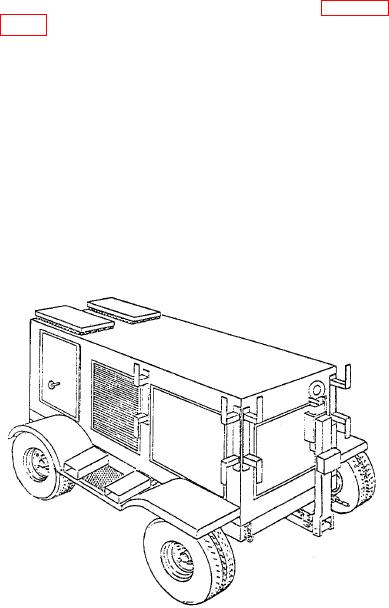
Shore power of 60 Hz can also be connected to
exciter field control, over/undervoltage monitoring,
the PHM through two connectors on a common
and underfrequency monitoring.
housing attached to the aft bulkhead of the
deckhouse on the starboard side. One receptacle
The control panel is hinged for easy access and
provides connection capability for 120-V, 3-phase
provided with a weatherproof shield to prevent direct
power, while the other receptacle provides the same
rainfall on the panel during operation of the controls
capability for 450-V, 3-phase power.
or observation of the instruments.
The shore power transformer is a 3-phase,
Mobile Electric Power Plant
single-core, isolating type. It takes power from the
power unit input terminals and provides two isolated,
Most piers where the PHM will dock cannot
ungrounded output circuits. The shore power system
provide the special power required by the hydrofoil's
is provided with both input and output circuit
electrical system. For this reason, mobile electric
breakers, instruments, and indicators.
power plants are usually shipped to the ports where
the PHM will be docked.
The mobile electric power unit is capable of
continuous duty. It can maintain the electrical and
Each mobile electric power unit is composed of a
physical performance characteristics required for the
motor generator and a shore power transformer. The
PHM under specified input and environmental
unit is completely equipped with voltage regulator
conditions. The unit operates on a 480-V ac, 3-phase, 60-
instruments, protective devices, and operating
Hz power source with a continuous rating of 150 kVA
controls enclosed in a weatherproof, ventilated
(180 amperes). It will supply 450-V ac, 3-phase, 400-Hz
housing. The entire enclosure is mounted on a
power to the PHM at 125 kW continuous duty.
steerable, highway towable, 4-wheel trailer. (See fig.
TROUBLESHOOTING PROCEDURES
The motor generator is a brushless, two-bearing,
salient-pole unit. The unit is self-ventilated. The
In troubleshooting the PHM's electrical system,
rotating brushless system consists of the salient-pole
you should first use the fault or out-of-tolerance
motor and generator rotor assemblies, fan assembly,
indications displayed on the electrical system control
rotating rectifier assembly and exciter armature
panel. You should then locate the associated fault
assembly, all mounted on a common shaft and
directory and fault trees in the appropriate technical
dynamically balanced.
manuals.
The voltage regulator unit is a completely static,
Use the panel indications and the appropriate
modular unit. It is provided with a plug-in connector for
guidelines in the technical manuals to analyze the
ease of removal and replacement. The regulator contains
symptoms of the trouble, isolate them to a probable
plug-in circuit modules for 3-phase voltage sensing,
cause, and recommend corrective procedures to
return the system to its operational condition. The
information you can derive from the panel
indications, the technical manuals, and the electrical
power system one-line diagram should provide you
with the information you will need to perform basic
fault isolation procedures.
In the preceding sections, you read about the
main propulsion, power train, control, and electrical
systems of the PHM. In the following section, we will
take a look at the auxiliary systems, their
components, and the relationship of these systems to
the engineering plant.
AUXILIARY SYSTEMS
The auxiliary systems of the PHM include the
following systems:
Fuel system
Hydraulic power system
Figure 6-37.--Mobile electric power plant.

